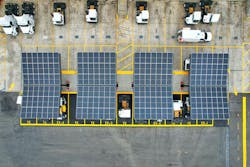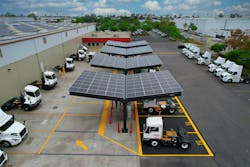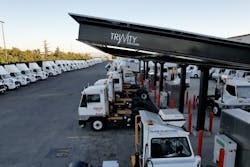No juice, no EVs: Utilities weak link in fleet transition
Emissions mandates, tax incentives, less complex fleet maintenance, and corporate environmental goals can lead companies to pursue fleet electrification. Government incentives are also trying to get decision-makers to contact EV dealers.
But so far, even in states like California with strict emissions regulations and rebate incentives, not all businesses are rushing to convert their ICE-powered trucks. Among the reasons is application, with electrifcation fitting better with select operations. Trucks that haul thousands of pounds over long stretches of highway don’t yet have an electric truck alternative that can adequately meet business requirements.
Another reason is the limited public charging infrastructure. Businesses with trucks that operate away from their home base don’t want to leave drivers stranded if they can’t find accessible—and functional—charging stations. That also includes private depot charging infrastructure obstacles holding back fleet electrification simply because they can’t access enough energy.
“We are seeing a major struggle between utility companies and major (private) fleets in the desire and ability to provide power,” Tim Owen, co-founder of Trinity Structures, told FleetOwner. “The utility companies just don’t have the amount of power that is going to be needed for what is coming” with fleet electrification.
This is the exact situation major wholesale retailer Costco fell into when looking to transition multiple trucks in its fleet. Costco (No. 168 on the 2023 FleetOwner 500: Top Private Fleets) was working on a tight schedule to build charging infrastructure at its facility before a grant funding deadline.
In Costco’s case, the company’s utility couldn’t provide the energy needed for Costco’s electric fleet in the timeframe required, Owen explained. And Costco isn’t the only large company finding energy availability an obstacle to electrification.
Owen has been approached by “many, many Fortune companies who’ve told us they can’t expand and they can’t grow because the utility company doesn’t have the power for them,” he said.
Infrastructure designed for the fleet’s needs
Trinity Structures is a turnkey provider of electrified structures that seamlessly create, convert, and conduct energy. Trinity acts as an EPC, or an entity that engineers, procures, and constructs these charging sites for its customers. But what makes Trinity different from other EPCs in the industry is that the company isn’t simply a “broker” that takes bids on projects to see what it can pull together. Instead, Trinity has a group of “definitive partners” that help it focus on building the system architecture, both structural and electrical, in advance so that it can be integrated into a single design built around a Trinity-developed product.
Darin Leonard, who co-founded Trinity Structures with Owen, explained this: If a fleet customer wants to deploy renewable energy in one of their facilities, they use an EPC. These EPCs build an operating design that can be engineered, procured, and constructed for their customers. Leonard said the general contractors of the EPCs will procure different products and teams for these sites, such as solar panels, structural solutions, batteries, inverters, EV chargers, electrical contractors, electrical engineers, and more.
See also: Truck charging in the real world
Leonard assured that EPCs are often reputable organizations, but there is a “big flaw in their model.” The flaw is that these products and contracting groups don’t come together until the day of on-site installation. This lack of teamwork and communication often leads to inoperable EV charging infrastructure or infrastructure that takes years to build.
To solve the problem, Owen and Leonard developed a methodology that engages with the corporate customer first to discover what each group is trying to accomplish, then build a plan around the customer’s needs. With Costco, Trinity experts sat down with Costco’s energy, construction, and fleet groups. Trinity then built “an operating plan and a site design that can be handed directly over to any PC,” or procurement and construction organization, according to Leonard.
Having this system designed in advance also quickens the deployment date of the on-site charging infrastructure, a process that can take more than two years to complete. Costco’s charging stations were up and running in the short span of just four months.
Energy independence
Trinity’s partnerships and advanced design take the credit for an infrastructure deployment within this timeframe. But one aspect that made this process so quick was that Trinity deployed an off-grid charging system for Costco’s EV fleet.
Why use an off-grid charging infrastructure? Aside from the fact that working with a utility to bury electric cable is a process that can take years, Costco’s utility provider couldn’t supply the energy its electric fleet required, which goes back to that not-so-widely known fleet electrification obstacle.
“One Class 8 EV truck takes one megawatt[-hour] of energy a day to charge,” Leonard told FleetOwner. That’s about enough energy to provide instantaneous demand for 750 homes, according to California ISO.
If a California-based fleet owner or operator were to ask their utility company for the necessary energy to power a fleet of electric semi-trucks, “the state of California utility is not going to give them 1 [MWh] of energy per day, per 12 trucks, or 20 trucks, or 60 trucks. So how do they solve that problem?” Leonard said.
They solve that problem through energy independence.
“Our goal is to design an ecosystem that works operationally with the customer,” Owen explained. “We look to work symbiotically with the power and utility companies when we can; however, when there are situations that our customers’ operational needs demand, we will have to go outside that to be off-grid.”
Leonard said Trinity has a current customer that is being pressured by California and environmental groups to expand the renewable energy on its property while also receiving strict emissions requirements to convert its vehicles away from ICE.
“The problem is nobody’s talking about the fact that ... the utilities cannot provide the power for it,” Leonard said.
Trinity sits in the middle of a “two-point discussion” to discover:
- If a customer requires expanded renewable energy at its properties to meet its own climate goals and the goals of the state they live; and
- If the customer’s utility can even provide that power. If the utility can’t provide that power, as in Costco’s case, Trinity will develop an infrastructure that gives the customer energy independence through solar panels. The solar panels Trinity installed at Costco’s facility can generate up to 100 megawatt-hours of energy annually, providing more than 11,000 hours of fleet charging.
Trinity is designing a 100% solar-powered infrastructure for another customer in Alaska to charge its fleet vehicles and generate power for its facility. Once the project is complete, this customer will almost “eliminate” their energy bills due to the high cost of power in Alaska, Leonard told FleetOwner.
“When you’re working with a fleet partner who’s looking at a significant investment in their fleet operations going forward,” Owen said, “showing a greater ROI when you generate your own energy, and you can place that energy where you want it to go ... that is a key pivotal point in our value proposition.”
About the Author
Jade Brasher
Senior Editor Jade Brasher has covered vocational trucking and fleets since 2018. A graduate of The University of Alabama with a degree in journalism, Jade enjoys telling stories about the people behind the wheel and the intricate processes of the ever-evolving trucking industry.



